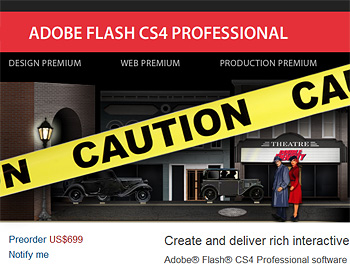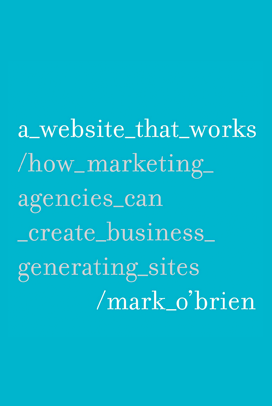Now that Eric, our former CEO, is off to new heights in his career, I’ve invited him to contribute a few guest blog posts. This is the ninth of several that he’ll share in the coming months.

After studying at the Rhode Island School of Design, Eric Holter worked as an engraver and illustrator for Pagano, Schenck & Kay Advertising, then as a web designer at Leonard/Monahan. He founded Newfangled Web Factory in 1995. |

This may be the most controversial of my series on advertising agency website gaffes. I’ve been advising agencies to avoid Flash as their website platform for…, well, ever since Flash existed. Let me make it clear from the outset that I’m not against Flash. It’s a great tool that, when used properly, can have a positive impact on website design and functionality. I am, however, against Flash as the primary platform in almost every case (exceptions would include certain website applications, web-based games, and some entertainment-oriented websites). By “primary platform” I mean that the entire website is contained inside a Flash movie file (or series of movie files). I’ve already addressed six reasons why Flash is not a great website development platform in a previous post about Google’s announcement that it now indexes Flash-based content. I suggested six reasons why this was not great news. My overall point was that agencies would now be even more inclined to use Flash–without realizing that there are still significant weakness with the Flash platform. And without very careful attention to Flash programming details, site content can still be locked up by Flash.
Here is a brief recap of the problems identified in the previous post
.
- Content weakness. Agency sites built in Flash tend to be weak on content and rarely updated.
- URL Linking. Most Flash sites consist of one large Flash movie. This makes linking to a particular page within an agency site impossible.
- Meta Data. Even with Google’s changes, Flash-based sites offer very few opportunities for search engine optimization.
- Content Prioritization. An indexed Flash file is searchable, but the content lacks any underlying tags that help search engines determine the relevance and weight of the content.
- Content Management. Flash is sometimes chosen not because it’s the best platform for the site, but because it’s the easiest tool (for a designer) to master. Which means the site is not likely to have a robust content management system–which means fewer content updates.
- Distraction of Style Over Substance. More often than not a Flash-based agency website becomes the creative outlet instead of being a place where the agency showcases their creative work and thinking.
The reasons above (see the post for more details on those points) should be enough to persuade agencies to put Flash away and build their websites using standard web platforms.
But often these objective reasons are not enough. I think that’s because the causes of agency Flash dependence go deeper–so deep in fact, that the objective problems with Flash don’t seem to matter to them. Here are some of the underlying reasons that advertising agencies are so entrenched in Flash.
The Creativity Barrier
The “Creativity Barrier” is one of main causes of agency web strategy failure. Traditional agencies are geared to use their creative talents to help their clients overcome consumer inertia and information overload in order to deliver a message. Getting attention is a prerequisite before anything else can be accomplished. But this dynamic is drastically minimized, even eliminated on the web. People click links or type in URLs on their own initiative–not because their attention has been captured by creativity.
The misaligned creative impulse stems from not understanding the role of creativity in web strategy. But there’s more to it. When it comes to the agency’s own website the creativity barrier gets much stronger due to years of pent-up creative frustrations. When agencies present their creative ideas to clients they usually include a few different options. There’s usually at least one bold creative concept (the agency’s favorite). Then there are the other safer, slightly little less creative ideas. To the creative director’s dismay, clients almost always pick the safer ideas. And sometimes they want to water down the already safe concept–draining out out every last bit of creative boldness.
After years of great creative ideas being reined in by clients, agencies need an outlet with less creative resistance (which is why so many creative awards happen to be for the agency’s pro-bono clients). So when it comes to the agency’s own website there’s no client to muck with great creative ideas. The agency can be as bold as they like. And the Flash platform affords them all sorts of opportunities to go nuts: sound, video, animation, transitions. The agency can finally express its unrestrained creativity.
But in the end, these agency Flash sites (while certainly impressive demonstrations of creativity) end up delivering the wrong message. They succeed at saying “we’re really creative” but at the cost of adding the message “but we don’t get web strategy.” The same site on which you claim expertise for guiding clients into the right strategic mix of marketing channels (usually including web) betrays this claim–at least in regard to web strategy. Your example states “we’re willing to forgo a powerful marketing channel for an opportunity to be really creative.”
Project Orientation Rather Than Strategic Orientation
Most “process” pages on agency websites follow something like this pattern: step one–we {evaluate, research, ask, orient}, step two–we {think, plan, strategize}, step three–we {design, create, innovate}, and step four–we {evaluate, measure, refine}. Each step usually starts with a “D” or “P” for alliteration. There’s nothing wrong with this kind of page (though they’re not as differentiating as they ought to be). But have you ever read such a page that didn’t not include a think, plan, or strategize step? Of course not. Nobody proceeds straight to design without thinking first.
Now this may hurt a bit. If we’re sober and honest in evaluating the real depth of our strategic efforts, we’re going to find that we’re really more tactical than we are strategic. In fact, we usually enter into assignments with most of the strategic issues already mandated by the client. Or if not mandated, we establish our tactics even as we hear the assignment for the first time. We’re already thinking, or have been told, that the assignment requires a six page brochure, or a full spread ad, or a point of purchase display. We then move eagerly to the design step.
If you want to check yourself on this reality, just consider how often your clients pay you just for strategy (without rolling it into the project fee or before establishing the project budget in advance). How many clients give you time to deliver a strategy before defining the deliverables and costs? The reality is that many of our firms are more project-oriented and tactical than we are strategic. We all want to think of ourselves as being more strategic (perhaps that’s because we equate “strategic” with “important”) than we really are.
Because we tend to be project-oriented, we think about our own agency site as an internal project–rather than a long term strategy. You can tell that most Flash-based agency websites were treated like internal projects when viewing time stamped content. News items or press releases on agency Flash sites are often very old. It’s because there was never any serious strategic thought given to the on-going content strategy. And if there had been serious thought, the choice to use a Flash-based platform would have been evaluated with more scrutiny.
Instead, someone was tasked with the project of designing an amazingly creative agency website. And once produced and launched, it’s rarely thought about again.
Technology Barriers
Another reason agencies use Flash is that they feel more comfortable with Flash technology than standard web technology platforms (php, asp, ruby, html, caa, javascript, etc.). They are already masters of Adobe software and Flash, while not simple, feels familiar and within their technical reach. To move away from Flash would mean using other, more complex technologies or leaning on technology partners to deliver them. I empathize with the fear of making bad technology choices. And there are many disaster stories that resulted from the uneasy alliances between creative firms and technology companies. There are even more horror stories of freelancers disappearing in the middle of a project, or becoming unavailable to maintain a site when it’s done.
Such problems usually mean that web projects are often unprofitable, almost always frustrating, and in the worst cases threaten an otherwise healthy agency/client relationship. But despite the risks, the days are long gone when a client will accept a Flash-based website from an agency. The agency might be willing to forgo all the amazing benefits a mature website can bring, but clients are not so easily satisfied. So whether it’s for the agency’s site or for an agency client’s website, creative firms must learn how to hire or partner with technology providers.
Lack of Experience With, and Appreciation for, the Power of Content
Agencies are satisfied with Flash, in part, because they have not tasted the power of the web in their own new business development efforts. The previous post described how Flash sites simply don’t perform as well as standard websites. And even non-Flash sites don’t see much action if there’s not a focused, sustainable content strategy in place. But when there is, the power of content on the web is amazing. You probably only come to value this after your first experience of having a well qualified prospect call you after reading much of the content on your site. They’ve already convinced themselves you are the agency for their business. They understand what you do and who you do it for. The sales process is so much easier when qualified, educated prospects approach you. And great websites make this happen.
But since most agency sites perform so badly, the agency has no appreciation for the power of content on the web. Their minimization of the importance of web strategy becomes a self-fulfilling reality. They get no results from their site, so they don’t value the web enough overall. As a result they don’t make efforts to improve/maintain the site, and so the poor performance continues. But ask yourself–why do agencies like Currency Marketing keep up with such a robust content strategy if it doesn’t work? It does work. And every effort of content creation has a considerable shelf life. It keeps working for years, sometimes while you sleep. Every effort becomes a deposit in the marketing bank account. But this doesn’t happen for cool Flash websites.
Moving Beyond Flash
Well, that’s all I got. If you’re still convinced that Flash is the right platform for your agency’s website–good luck with that. But I hope that you’ll take a sober look at your Flash site’s performance and see how much more there is to gain by moving past Flash. If you do decide to move beyond Flash let me know!

